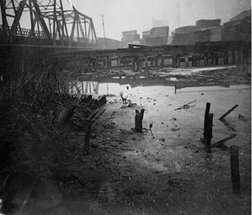 One of the distinctive (distinktive?) features of Chicago over the last couple of centuries has been the pollution in the Chicago River. The book I'm currently writing (The Resurrectionist's Apprentice) is set in 1874 Chicago. At that time, raw sewage and the offal from the stockyards and slaughterhouses was being dumped directly into the river, which then flowed (most of the time) toward Lake Michigan. By 1869 the river had gotten so disgusting that the city appointed a "Smelling Committee," whose job was to travel up and down the river--in August, the hottest time of year--to report on the water quality. The mayor, sanitary superintendent, the health officer, and others boarded a boat in the main branch of the river, the least offensive area in the city limits, and headed south. Along the way, they encountered a carcass, which some of them thought to be a pig, others a cat, boys who had been swimming whose skin was "tinged by the black water," the noteworthy "Twelfth Street" and "Eighteenth Street" smells, distinctive enough to have their own names, and sights such as "The water came up thick and black. The surface was covered with a filthy froth and bubbles of gas, while a terrible stench rose over the inky water ..." They passed a defunct slaughterhouse with a wretched odor caused by hams decomposing for years in the river, and distilleries that reeked of "two acres of decaying swill." At the end of the trip, the Tribune reporter onboard wrote that "the river is greatly improved since the last inspection." "Bubbly Creek," was a fork of the south branch of the river at the southern boundary of the Union Stockyards. As you might surmise from the name and location, the meatpackers used this body of water as their sewer and dump sight. The decomposition of blood, entrails, and diseased animals caused the creek to bubble night and day. For years, the meatpackers played a game of cat and mouse with the Smelling Committee. When they were forbidden to dump their offal in the river, they began doing so at night, and then only after the posted detectives would leave. Somehow, they always found a way to dump their waste in the river. This made the 1871 attempt to reverse the flow of the river a higher priority of the city's fathers, but the refuse continued to flow through downtown until the successful reversal of the river in 1900, when Chicago began shipping its sewage and slaughterhouse byproducts downriver, and it was no longer their problem.
6 Comments
|
AuthorD.E. Johnson: Archives
August 2016
Categories
All
|
 RSS Feed
RSS Feed